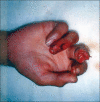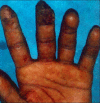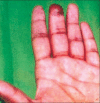Fingertip injuries
- PMID: 21139772
- PMCID: PMC2989143
- DOI: 10.4103/0019-5413.32051
Fingertip injuries
Abstract
Background: Fingertip injuries are extremely common. Out of the various available reconstructive options, one needs to select an option which achieves a painless fingertip with durable and sensate skin cover. The present analysis was conducted to evaluate the management and outcome of fingertip injuries.
Materials and methods: This is a retrospective study of 150 cases of fingertip Injuries of patients aged six to 65 years managed over a period of two years. Various reconstructive options were considered for the fingertip lesions greater than or equal to 1 cm(2). The total duration of treatment varied from two to six weeks with follow-up from two months to one year.
Results: The results showed preservation of finger length and contour, retention of sensation and healing without significant complication.
Conclusion: The treatment needs to be individualized and all possible techniques of reconstruction must be known to achieve optimal recovery.
Keywords: Avulsed fingertip; fingertip injuries; fingertip lacerations.
Conflict of interest statement
Figures
References
-
- Kelsey Jl, Pastides H, Kreiger N, et al. Upper extremity disorders: A survey of their frequency and cost in the United States. Mosby: St Louis, Mo; 1980.
-
- Beasley RW. Reconstruction of amputated fingertips. Plast Reconstr Surg. 1969;44:349–52. - PubMed
-
- Lister G. The hand: Diagnosis and indications. 3rd ed. Edinburgh: Churchill Livingstone; 1993. pp. 121–5.
-
- Rosenthal EA. Treatment of fingertip and nail bed injuries. Orthop Clin North Am. 1983;14:675–97. - PubMed
-
- Evans DM, Bernadis C. A new classification for fingertip injuries. J Hand Surg Br. 2000;25:58–60. - PubMed
LinkOut - more resources
Full Text Sources
Medical






